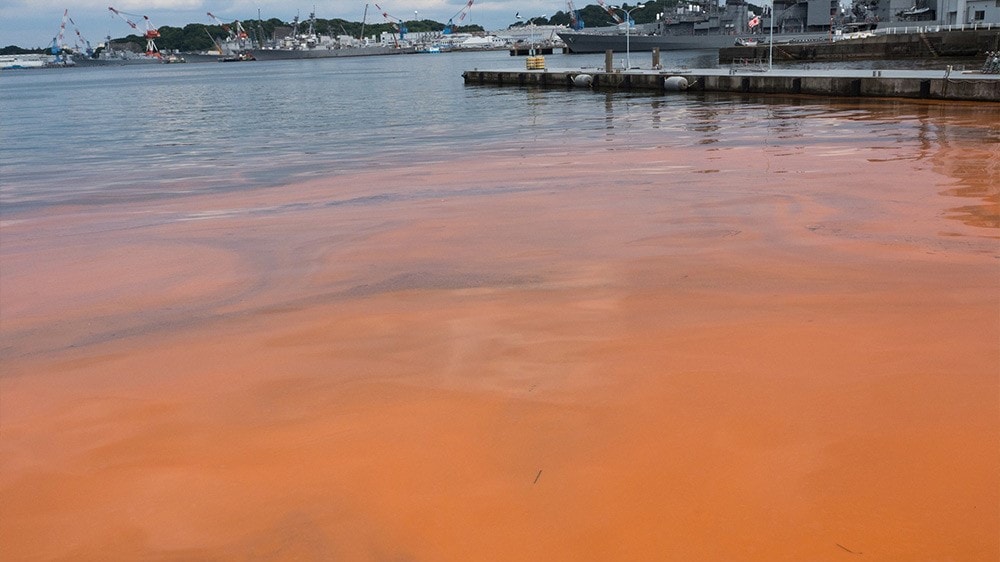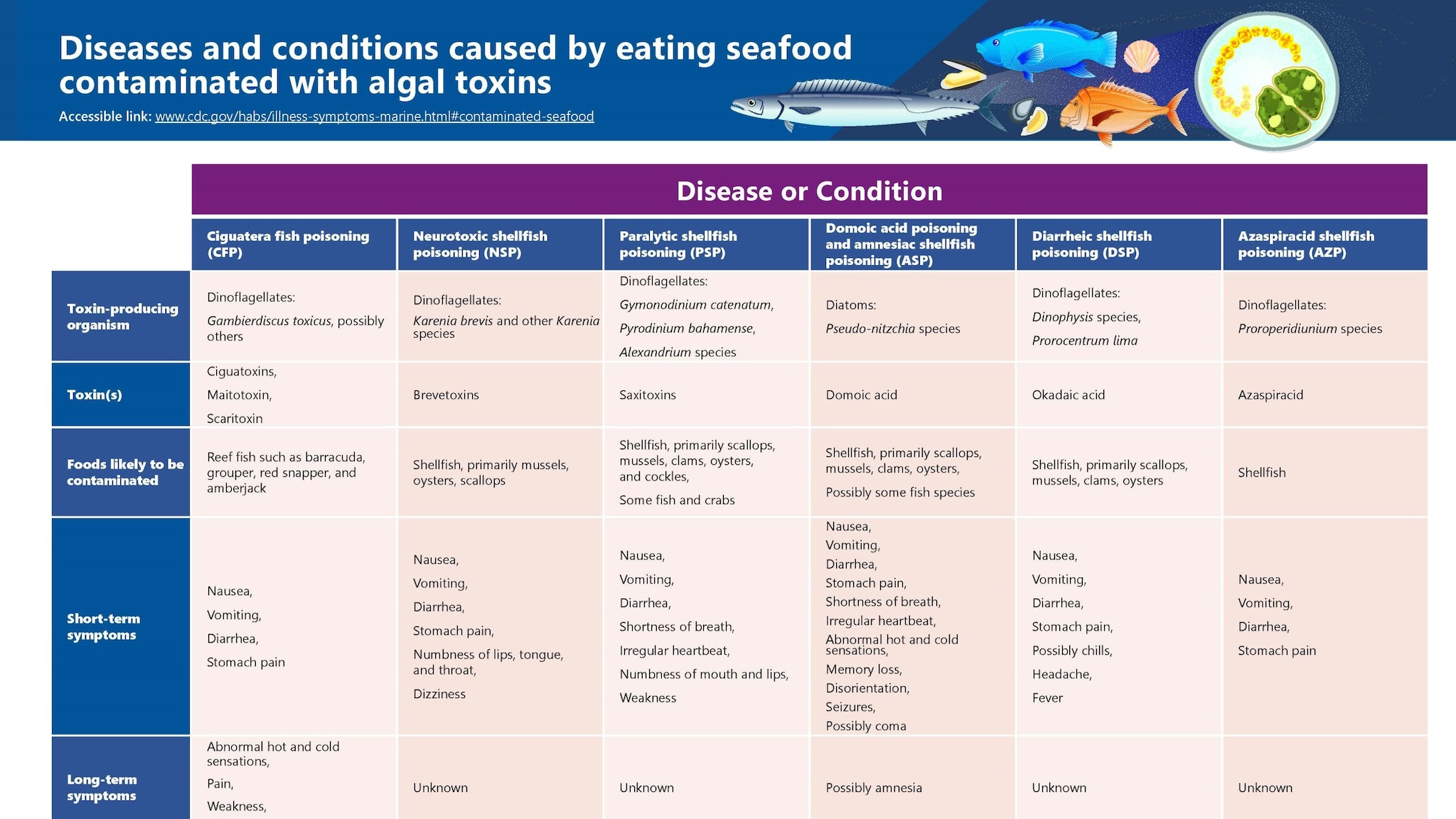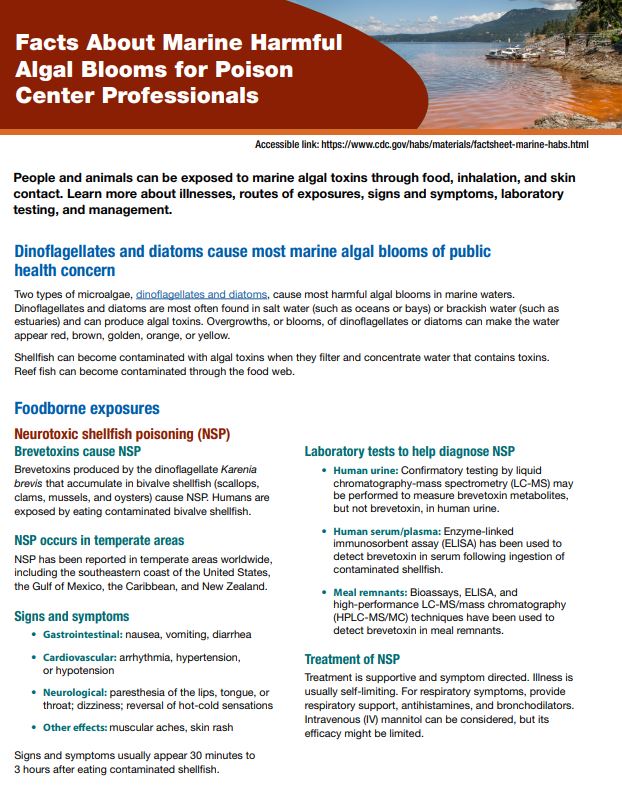Key points
- Harmful algal blooms in oceans and other bodies of salt water can make toxins.
- Signs and symptoms caused by these harmful algal blooms vary based on toxin and exposure.
- Illnesses can be mild to life-threatening.

Exposure and symptoms
Skin contact
Karenia brevis red tides in the Gulf of Mexico (a specific type of harmful algal bloom) can make brevetoxins. Having skin contact with brevetoxins can cause skin and mucous membrane irritation. People may have skin contact while swimming, wading, or doing other activities in water during a Karenia brevis red tide.
Inhalation
Brevetoxins
People who go in or near the water during Karenia brevis red tides can breathe in brevetoxins in seaspray.
Inhaling brevetoxin can lead to serious health effects including:
- Shortness of breath
- Asthma exacerbation
- Bronchoconstriction
- Bronchitis
- Pneumonia
Palytoxins
Palythoa and Zoanthus corals produce respiratory irritants called palytoxins. Exposures are primarily limited to those in the aquarium trade and people with saltwater aquariums containing these corals. Palytoxins can cause severe respiratory irritation when inhaled. These patients may require hospitalization.
Foodborne exposure
Eating seafood contaminated with harmful algal bloom toxins can affect different organ systems, causing a variety of signs and symptoms. Keep reading for more information about specific seafood poisoning diseases and conditions caused by harmful algal blooms in salt water.
Neurotoxic shellfish poisoning
Eating bivalve shellfish (scallops, clams, mussels, or oysters) contaminated with brevetoxins can cause gastrointestinal, cardiovascular, neurologic, or other health effects. Signs and symptoms usually appear 30 minutes to 3 hours after eating contaminated shellfish.
Gastrointestinal effects
- Nausea
- Vomiting
- Diarrhea
Cardiovascular effects
- Hypotension
- Hypertension
- Arrhythmia
Neurological effects
- Enhanced hot and cold sensations
- Paresthesia of the lips, tongue, or throat
- Dizziness
Other effects
- Muscle aches
- Skin rash
Ciguatera poisoning
Eating reef fish or seafood contaminated with ciguatoxins can cause gastrointestinal, neurologic, respiratory, or other health effects. Reef fish include barracuda, grouper, red snapper, and amberjack.
The effects vary based on the time since the food was eaten and the geographic location where the seafood was harvested. Reports suggest that Caribbean ciguatera poisoning presents with gastrointestinal symptoms first, followed by neurologic effects. In contrast, Pacific ciguatera poisoning presents with neurologic symptoms first, with or without subsequent gastrointestinal symptoms.
1–6 hours after exposure
Gastrointestinal effects
- Nausea
- Diarrhea
- Abdominal pain
- Vomiting
Neurologic effects
- Metallic taste
- Weakness
- Paresthesia of palms of hands and feet, lips, and mouth
- Enhanced hot and cold sensations
- Tooth pain
- Sensation of loose teeth
Respiratory effects
- Shortness of breath
- Respiratory depression
Other symptoms
- Blurry vision
- Arthralgia
- Myalgia
Severe signs
1–5 days after exposure
Cardiovascular effects
- T-wave abnormalities
- Bradycardia
- Hypotension
Months to years after exposure
- Persistent fatigue and paresthesia
- Recurring symptoms when patients eat certain foods, such as fish or nuts, or drink alcohol
Amnesic shellfish poisoning
Eating bivalve shellfish or Dungeness crab viscera contaminated with domoic acid can cause gastrointestinal, cardiovascular, neurologic, or respiratory health effects. Bivalve shellfish include scallops, mussels, razor clams (Siliqua patula), and oysters. Signs and symptoms usually occur within 24 hours of eating the contaminated shellfish.
Gastrointestinal effects
- Nausea
- Abdominal cramps
- Diarrhea
- Vomiting
Cardiovascular effects
- Hypertension
- Hypotension
- Arrhythmias
Neurological effects
- Paresthesias
- Enhanced hot and cold sensations
- Burning in the teeth or extremities
- Confusion
- Disorientation
- Memory loss (potentially chronic amnesia)
- Rarely, seizures or coma in severe cases
Respiratory effects
- Excessive secretions
- Shortness of breath
- Pulmonary edema
- Possibly paralysis
Diarrhetic shellfish poisoning
Eating bivalve shellfish (scallops, mussels, clams, or oysters) contaminated with okadaic acid, dinophysistoxins, or pectenotoxins can cause gastrointestinal and other health effects. Signs and symptoms are usually mild and occur within 2 hours after exposure. Onset and severity of illness are based on the amount of toxin ingested. Signs and symptoms are self-limited and resolve in 3 to 4 days.
Signs and symptoms
- Chills
- Headache
- Nausea
- Abdominal pain
- Diarrhea
- Vomiting
- Fever
Paralytic shellfish poisoning
Eating seafood contaminated with saxitoxin, neosaxitoxins, or tetrodotoxin can cause gastrointestinal, cardiovascular, neurologic, or respiratory health effects. Signs and symptoms usually occur within minutes to less than 24 hours after eating contaminated food. Signs and symptoms can last days to weeks.
Gastrointestinal effects
Patients may have nausea and vomiting, mainly resulting from pufferfish poisoning.
Cardiovascular effects
- Hypertension
- Hypotension
- Arrhythmias
- Chest pain
Neurological effects
- Headache
- Dizziness
- Paresthesia
- Numbness of the lips, tongue, neck, face, or extremities
- Ataxia
- Dysphagia
- Dysphonia
- Tongue immobilization
- Loss of gag reflex
- Nystagmus
- Temporary blindness
- Iridoplegia
- Jaw and facial muscle incoordination
- Flaccid paralysis
Muscle weakness and muscle incoordination can be chronic.
Respiratory effects
- Shortness of breath
- Respiratory failure
Respiratory paralysis
Azaspiracid shellfish poisoning
Eating bivalve shellfish (scallops, mussels, clams, or oysters) contaminated with azaspiracid toxins can cause gastrointestinal and other health effects. Signs and symptoms usually start within 24 hours after exposure and last for days.
Signs and symptoms
- Chills
- Headache
- Nausea
- Abdominal pain
- Diarrhea
- Vomiting
- Fever
Poisoning from palytoxins
Eating fish or crustaceans (such as xanthid crabs from the Philippines or sardines from Madagascar) contaminated with palytoxins has been reported to cause gastrointestinal illness and other health effects.
Signs and symptoms
Signs and symptoms reported from isolated poisoning events:
- Muscle cramps
- Numbness of extremities
- Abdominal pain
- Vomiting
Resources
- Food Poisoning from Marine Toxins | CDC Yellow Book
- Distribution of Harmful Algal Blooms in the U.S. | Woods Hole Oceanographic Institution
- Azziz-Baumgartner E, Luber G, Conklin L, Tosteson TR, Grenade HR, Dickey RW, Backer LC. Assessing the incidence of ciguatera fish poisoning with two surveys conducted in Culebra, Puerto Rico, during 2005-2006. Environ Health Perspect. 2012;120(4):526-9.
- Backer LC. Impacts of Florida red tides on coastal communities. Harmful Algae. 2009;8(4):618-22.
- Backer L, McGillicuddy DJ Jr. Harmful Algal Blooms: At the interface between coastal aceanography and human health. Oceanography. 2006;19(2):94-106.
- Backer LC, Kirkpatrick B, Fleming LE, Cheng YS, Pierce R, Bean JA, Clark R, Johnson D, Wanner A, Tamer R, Baden D. Occupational exposure to aerosolized brevetoxins during Florida red tide events: Impacts on a healthy worker population. Environ Health Perspect. 2005;113-5:644-9.
- Berdaleti E; Fleming LE, Gowen R, Davidson K, Hess P, Backer LC, Moore SK, Hoagland P, Enevoldsen H. Marine harmful algal blooms, human health and wellbeing: challenges and opportunities in the 21st century. J Mar Biol Assoc U.K. 2015;2015. doi:10/1017/S0025315415001733.
- Bienfang PK, DeFelice SV, Laws EA, Brand LE, Bidigare RR, Christensen S, Trapido-Rosenthal H, Hemscheidt TK, McGillicuddy DJ, Anderson DM, Solo-Gabriele HM, Boehm AB, Backer LC. Prominent human health impacts from several marine microbes: history, ecology, and public health implications. Int J Microbiol. 2011;2011:152815.
- Cheng YS, Zhou Y, Irvin CM, Pierce RH, Naar J, Backer LC, Fleming LE, Kirkpatrick B, Baden DG. 2005. Characterization of marine aerosol for assessment of human exposure to brevetoxins. Environ Health Perspect. 113-5:638.
- Deeds JR & Schwartz MD. Human risk associated with palytoxin exposure. Toxicon. 2010;56(2):150-162
- Fleming LE, Backer LC, Baden DG. Overview of aerosolized Florida red tide toxins: exposures and effects. Environ Health Perspect. 2005;113(5):618-20.
- Fleming LE, Bean JA, Kirkpatrick B, Cheng YS, Pierce R, Naar J, Nierenberg K, Backer LC, Wanner A, Reich A, Zhou Y, Watkins S, Henry M, Zaias J, Abraham WM, Benson J, Cassedy A, Hollenbeck J, Kirkpatrick G, Clarke T, Baden DG. Exposure and effect assessment of aerosolized red tide toxins (brevetoxins) and asthma. Environ Health Perspect. 2009;117(7):1095-1100.
- Kirkpatrick B, Fleming LE, Bean JA, Nierenberg K, Backer LC, Cheng YS, Pierce R, Reich A, Naar J, Wanner A, Abraham WM, Zhou Y, Hollenbeck J, Baden DG. Aerosolized red tide toxins (brevetoxins) and asthma: Continued health effects after 1h beach exposure.Harmful algae. 2011;10(2):138-43.
- Kirkpatrick B, Fleming LE, Squicciarini D, Backer LC, Clark R, Abraham W, Benson J, Cheng YS, Johnson D, Pierce R, Zaias J, Bossart GD, Baden DG. Literature review of Florida red tide: implications for human health effects. Harmful Algae. 2004;3(2):99-115.
- Milian A, Nierenberg K, Fleming LE, Bean JA, Wanner A, Reich A, Backer LC, Jayroe D, Kirkpatrick B. Reported respiratory symptom intensity in asthmatics during exposure to aerosolized Florida red tide toxins. J Asthma. 2007;44(7):583-87.
- Penotti R, Scallan E, Backer L, Thomas J, Angulo FJ. Ciguatera and scombroid fish poisoning in the United States. Foodborne Pathog Dis. 2013;10(12):1059-66.
- Pierce RH, Henry MS, Blum PC, Hamel SL, Kirkpatrick B, Cheng Y-S, Zhou Y, Irvin CM, Naar J, Weidner A, Fleming LE, Backer LC, Baden DG. Brevetoxin composition in water and marine aerosol along a Florida beach: Assessing potential human exposure to marine biotoxins. Harmful Algae. 2005;4:965-972.
- Shoemaker RC, Hudnell HK. Possible estuary-associated syndrome: symptoms, vision, and treatment. Environ Health Perspect. 2001;109(5):539-45.
- Swinker M, Tester P, Koltai Attix D, Schmechel D. Human health effects of exposure to Pfiesteria piscicida: a review. Microbes Infect. 2002;4(7):751-62.


